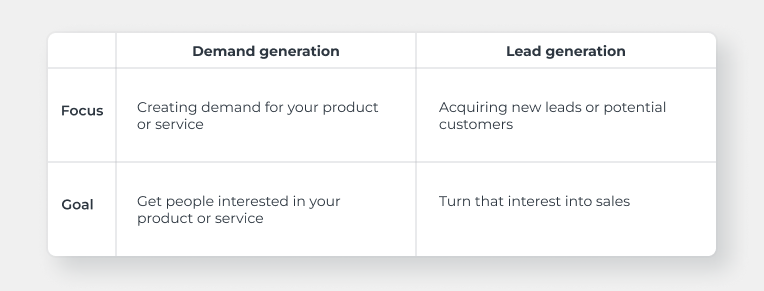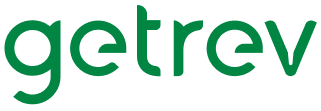Demand generation vs lead generation? Learning the difference between these two strategies is simple.
Demand generation is the process of building awareness and interest in your brand by showing potential prospects you understand their problem. Lead generation, on the other hand, is the process of converting those prospects into leads or customers by convincing them your brand has a solution to their problem.

So, if it’s that simple, where does the confusion come from? Why do so many B2B marketers still use these terms interchangeably?
Because these two marketing strategies usually work together. So, the line between the two easily gets blurred. Still, many companies neglect one of them, which can end up being a costly mistake. Why? In this blog post, we’re gonna show you why as we look at:
- Examples of marketing tactics to generate demand and generate leads
- How a strong demand generation strategy makes lead generation easier
- Real examples of companies successfully infusing demand generation and lead generation to create greater marketing impact
- How one company generated $1.5 billion in sales using an AI-powered demand generation strategy
Ready? Let’s get to it!
Demand generation vs lead generation: Marketing tactics
Remember: Demand generation is all about building awareness and interest in your brand by showing potential prospects you understand their problem. So, how do you do that?
By educating them on the problem and presenting your brand as a thought leader by using marketing tactics, like:
- Content marketing: Create informational, top-of-the-funnel blog posts, infographics, video tutorials, podcasts, webinars, etc.
- Search engine optimization (SEO): Make it easy for prospects to find your website and content on search engine platforms when searching for terms related to the problems your business helps solve.
- Social media marketing: Publish engaging, valuable content that resonates with your ICP on the social media platforms where they spend the most time.
- Email marketing: Send updates about your product or service, thought leadership pieces on topics relevant to your industry, promotional offers and more.
- Advertising: Promote your demand generation content through Google Ads, LinkedIn Ads and other paid channels.
- Influencer marketing: Work with people who have a strong online presence in your industry to promote your content to their audience.
- PR campaigns: Reach out to journalists, bloggers, and other members of the press to get them to write about your business or feature your demand generation content.
- Free resources: Offer something of value that people can use for free, such as a template or tool (e.g. a loan calculator from a financial service).
- Content syndication: Get your demand generation content featured on other websites and in front of new audiences.
Now, if you’re thinking, “Those are a lot of the same tactics we use to generate leads,” you’re not wrong. There’s a lot of overlap when it comes to tactics for demand gen and lead gen–especially since lead gen technically falls under the umbrella of demand gen. Still, it’s the intention and execution of those marketing tactics that make the difference.
Remember: Lead generation is about converting prospects who have begun to see your business as a potential solution to their problem. How exactly do you do that?
By giving prospects in-depth information about your solution, showing them you’ve solved problems similar to their problems before and moving them down your sales funnel with marketing tactics, like:
- Content marketing: Create informational, bottom-of-the-funnel content, such as a whitepaper, that prospects will want in exchange for their contact information.
- Search engine optimization (SEO): Improve your website’s ranking for commercial and transactional keywords in search results so that when prospects look for a solution to their problem, they find you.
- Search engine marketing (SEM): Place ads on search engines like Google so that when prospects perform searches related to your solution, they find links to your website and landing pages.
- Social media marketing: Use social media platforms like LinkedIn and Twitter to reach out to prospects and build relationships.
- Email marketing: Send emails that prospects will want to read, with the goal of getting them to click through to your website or landing pages.
- Advertising: Place ads about promotions and special offers on websites your target audience visits.
- Influencer marketing: Collaborate with industry thought leaders and have them promote your brand to their audience.
- Free trials and demos: Offer free trials or demos of your product or service so prospects can see the value for themselves.
Why a strong demand generation strategy makes lead generation easier
Marketers often fall into the trap of thinking that lead generation is the only goal. But without demand for your product, lead generation is an uphill battle. That’s why demand generation should be the focus first and foremost.
If you build demand first, lead generation becomes much easier because people are already interested in what you’re selling. How do you begin? Read our demand generation strategy guide to learn how to start generating demand from your ideal customers.
Examples of demand generation and lead generation
Now let’s look at some real examples to help you further understand demand generation vs lead generation. Here are two B2B companies that strategically use demand generation and lead generation to get the most marketing impact.
Example 1: Ahrefs
Ahrefs is an SEO tool that helps people improve their search engine rankings. To create demand, Ahrefs offers a variety of valuable content, like blog posts, video tutorials and free courses on digital marketing. And since that content is so valuable for their target audience, it attracts a lot of interest and awareness of the Ahrefs brand.
Even better, when using blog posts or videos to explain common issues for business owners like, “How to do YouTube keyword research,” Ahrefs shows their audience how the Ahrefs platform provides the perfect solution. As a result, their demand generation content almost effortlessly generates leads without ever needing to make a hard sale.
Take a look for yourself.
Example 2: Monday.com
Monday.com is a project management software that provides teams with a platform to plan, track and visualize work progress. To generate demand, Monday.com focuses on top-of-the-funnel content like blog content and video ads that target business owners and managers. For example, here’s one of their best video ads.
Notice the video ad is short, sweet and to the point—which makes it easy to follow along and understand what Monday.com is all about. Without pushing, the ad also gently encourages viewers to sign up for a free 14-day trial.
Of course, if you do sign up for the trial, you then become a lead and begin receiving emails as part of a lead nurture sequence that encourages you to eventually subscribe to one of Monday.com‘s membership plans.
Both Ahrefs and Monday.com show that demand generation and lead generation can work together to create a seamless experience from marketing to sales. But our next example company was able to do something even more spectacular.
This company was able to go from having a list of seemingly dead leads to using a demand generation strategy that resulted in $1.5 billion in sales.
How one company increased pipeline by 15% using an AI-powered demand generation strategy
Splunk is a data software company that provides a platform for analyzing machine-generated big data. It’s used by organizations to gain insights into software operations, security and compliance. But, recently, they acquired a company in the DevOps space and needed a way to generate demand for a new offering in a new market segment.
Despite having an extensive ABM list, Splunk still struggled to find new prospects that would be interested in their solution. So, what did they do to generate enough demand and leads to make to increase pipeline by more than 15%?
To start, they used our Sales Development Platform to create a refined ICP. Since Rev uses AI technology to collect and analyze exegraphics—data on how companies operate and behave—Splunk’s new ICP became an aiCP (artificial intelligence customer profile) which continues to update as AI gathers more data on how Splunk’s best-fit customers operate and behave.
With the new aiCP, Rev was able to prioritize Splunk’s list and run a content syndication campaign, creating content that specifically targeted companies with the exegraphic markers for being the best fits for Splunk’s offer and the most ready to buy. In just three weeks, Splunk was able to attribute more than 15% of their pipeline to being high-quality MQLs that were prioritized using their aiCP.
Key takeaways
Demand generation and lead generation are two important but distinct marketing strategies. You can and should use both strategies to ensure the success of your business. Here’s what you need to remember to make sure you get the most out of each.
What is demand generation?
Demand generation is the process of creating awareness and demand for your product or service. It’s about getting your target market to see you as a trusted source of information and convincing them that you understand their problem.
What is lead generation?
Lead generation is the process of converting prospects into leads. It’s about taking those who display interest in what you have to offer and nurturing them through your funnel until they’re ready to buy.
Demand generation vs. lead generation: Which one should come first?
Demand generation. You can’t generate leads without first generating demand. If you do lead gen without demand gen, you’ll waste a lot of time and money on leads that go nowhere.
How can you ensure your demand generation strategy results in high-quality MQLs?
By first taking the time to understand your target prospects, their needs and how their business operates. Then, you’ll create and promote demand generation content that’s specific to their interests and pain points.
To maximize your efforts, create an aiCP. This will help you prioritize which companies to target based on exegraphic data that signals fit and readiness to buy from your company. Contact us, and we’ll give you a sample list of accounts that look and act like your best customers!


